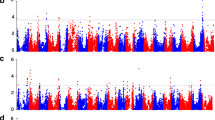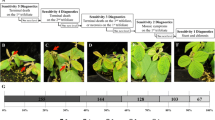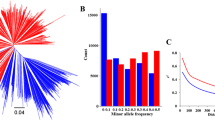Abstract
Key message
Genome-wide association analyses identified candidates for genes involved in restricting virus movement into embryonic tissues, suppressing virus-induced seed coat mottling and preserving yield in soybean plants infected with soybean mosaic virus.
Abstract
Soybean mosaic virus (SMV) causes significant reductions in soybean yield and seed quality. Because seedborne infections can serve as primary sources of inoculum for SMV infections, resistance to SMV seed transmission provides a means to limit the impacts of SMV. In this study, two diverse population panels, Pop1 and Pop2, composed of 409 and 199 soybean plant introductions, respectively, were evaluated for SMV seed transmission rate, seed coat mottling, and seed yield from SMV-infected plants. The phenotypic data and genotypic data from the SoySNP50K dataset were analyzed using GAPIT and rrBLUP. For SMV seed transmission rate, a single locus was identified on chromosome 9 in Pop1. For SMV-induced seed coat mottling, loci were identified on chromosome 9 in Pop1 and on chromosome 3 in Pop2. For seed yield from SMV-infected plants, a single locus was identified on chromosome 3 in Pop2 that was within the map interval of a previously described quantitative trait locus for seed number. The high linkage disequilibrium regions surrounding the markers on chromosomes 3 and 9 contained a predicted nonsense-mediated RNA decay gene, multiple pectin methylesterase inhibitor genes (involved in restricting virus movement), two chalcone synthase genes, and a homolog of the yeast Rtf1 gene (involved in RNA-mediated transcriptional gene silencing). The results of this study provided additional insight into the genetic architecture of these three important traits, suggested candidate genes for downstream functional validation, and suggested that genomic prediction would outperform marker-assisted selection for two of the four trait–marker associations.





Similar content being viewed by others
References
Anderson EJ, Kline AS, Morelock TE, McNew RW (1996) Tolerance to blackeye cowpea mosaic potyvirus not correlated with decreased virus accumulation or protection from cowpea stunt disease. Plant Dis 80:847–852
Balistreri G, Bognanni C, Muhlemann O (2017) Virus escape and manipulation of cellular nonsense-mediated mRNA decay. Viruses 9:24
Bao Y, Kurle JE, Anderson G, Young ND (2015) Association mapping and genomic prediction for resistance to sudden death syndrome in early maturing soybean germplasm. Molec Breed 35:128
Bernardo R (2014) Genomewide selection when major genes are known. Crop Sci 54:68–75
Bhat JA, Ali S, Salgotra RK, Mir ZA, Dutta S, Jadon V, Tyagi A, Mushtaq M, Jain N, Singh PK, Singh GP, Prabhu KV (2016) Genomic selection in the era of next generation sequencing for complex traits in plant breeding. Front Genet 7:221
Bian Y, Holland JB (2017) Enhancing genomic prediction with genome-wide association studies in multiparental maize populations. Heredity 118:585–593
Bowers GR Jr (1977) Seed transmission of soybean mosaic virus, Agronomy. University of Illinois, Urbana, p 100
Bowers GR Jr, Goodman RM (1979) Soybean mosaic virus: infection of soybean seed parts and seed transmission. Phytopathology 69:569–572
Bowers GR, Goodman RM (1991) Strain specificity of soybean mosaic virus seed transmission in soybean. Crop Sci 31:1171–1174
Brondum RF, Su G, Janss L, Sahana G, Guldbrandtsen B, Boichard D, Lund MS (2015) Quantitative trait loci markers derived from whole genome sequence data increases the reliability of genomic prediction. J Dairy Sci 98:4107–4116
Browning BL, Browning SR (2009) A unified approach to genotype imputation and haplotype-phase inference for large data sets of trios and unrelated individuals. Am J Hum Genet 84:210–223
Chang HX, Brown PJ, Lipka AE, Domier LL, Hartman GL (2016a) Genome-wide association and genomic prediction identifies associated loci and predicts the sensitivity of Tobacco ringspot virus in soybean plant introductions. BMC Genom 17:153
Chang HX, Lipka AE, Domier LL, Hartman GL (2016b) Characterization of disease resistance loci in the USDA soybean germplasm collection using genome-wide association studies. Phytopathology 106:1139–1151
Chen H, Seguin P, Jabaji SH (2009) Differential expression of genes encoding the phenylpropanoid pathway upon infection of soybean seedlings by Rhizoctonia solani. Can J Plant Pathol 31:356–367
Chen L, Ren F, Zhou L, Wang QQ, Zhong H, Li XB (2012) The Brassica napus Calcineurin B-Like 1/CBL-interacting protein kinase 6 (CBL1/CIPK6) component is involved in the plant response to abiotic stress and ABA signalling. J Exp Bot 63:6211–6222
Cirilli M, Rossini L, Geuna F, Palmisano F, Minafra A, Castrignano T, Gattolin S, Ciacciulli A, Babini AR, Liverani A, Bassi D (2017) Genetic dissection of Sharka disease tolerance in peach (P. persica L. Batsch). BMC Plant Biol 17:192
Desta ZA, Ortiz R (2014) Genomic selection: genome-wide prediction in plant improvement. Trends Plant Sci 19:592–601
Di Matteo A, Giovane A, Raiola A, Camardella L, Bonivento D, De Lorenzo G, Cervone F, Bellincampi D, Tsernoglou D (2005) Structural basis for the interaction between pectin methylesterase and a specific inhibitor protein. Plant Cell 17:849–858
Domier LL, Steinlage TA, Hobbs HA, Wang Y, Herrera-Rodriguez G, Haudenshield JS, McCoppin NK, Hartman GL (2007) Similarities in seed and aphid transmission among Soybean mosaic virus isolates. Plant Dis 91:546–550
Domier LL, Hobbs HA, McCoppin NK, Bowen CR, Steinlage TA, Chang S, Wang Y, Hartman GL (2011) Multiple loci condition seed transmission of Soybean mosaic virus (SMV) and SMV-induced seed coat mottling in soybean. Phytopathology 101:750–756
Endelman JB (2011) Ridge regression and other kernels for genomic selection with R package rrBLUP. Plant Genome 4:250–255
Garcia D, Garcia S, Voinnet O (2014) Nonsense-mediated decay serves as a general viral restriction mechanism in plants. Cell Host Microbe 16:391–402
German-Retana S, Walter J, Le Gall O (2008) Lettuce mosaic virus: from pathogen diversity to host interactors. Molec Plant Path 9:127–136
Goh L, Yap V (2009) Effects of normalization on quantitative traits in association test. BMC Bioinform 10:415
Grant D, Nelson RT, Cannon SB, Shoemaker RC (2010) SoyBase, the USDA-ARS soybean genetics and genomics database. Nucleic Acids Res 38:D843–D846
Hajimorad MR, Domier LL, Tolin SA, Whitham SA, Saghai Maroof MA (2018) Soybean mosaic virus: a successful potyvirus with a wide distribution but restricted natural host range. Molec Plant Path 19:1563–1579
Hill JH (1999) Soybean mosaic virus. In: Hartman GL, Sinclair JB, Rupe JC (eds) Compendium of soybean diseases, 4th edn. The American Phytopathological Society, St. Paul, pp 70–71
Hogg JR (2016) Viral evasion and manipulation of host RNA quality control pathways. J Virol 90:7010–7018
Kasai A, Ohnishi S, Yamazaki H, Funatsuki H, Kurauchi T, Matsumoto T, Yumoto S, Senda M (2009) Molecular mechanism of seed coat discoloration induced by low temperature in yellow soybean. Plant Cell Phys 50:1090–1098
Korte A, Farlow A (2013) The advantages and limitations of trait analysis with GWAS: a review. Plant Methods 9:29
Kowalik KM, Shimada Y, Flury V, Stadler MB, Batki J, Buhler M (2015) The Paf1 complex represses small-RNA-mediated epigenetic gene silencing. Nature 520:248-U294
Kuroda Y, Kaga A, Tomooka N, Yano H, Takada Y, Kato S, Vaughan D (2013) QTL affecting fitness of hybrids between wild and cultivated soybeans in experimental fields. Ecol Evol 3:2150–2168
Leeds P, Wood JM, Lee BS, Culbertson MR (1992) Gene products that promote mRNA turnover in Saccharomyces cerevisiae. Molec Cell Biol 12:2165–2177
Leinonen R, Sugawara H, Shumway M, C INSD (2011) The sequence read archive. Nucleic Acids Res 39:D19–D21
Lionetti V, Raiola A, Cervone F, Bellincampi D (2014a) How do pectin methylesterases and their inhibitors affect the spreading of tobamovirus? Plant Signal Behav 9:e972863
Lionetti V, Raiola A, Cervone F, Bellincampi D (2014b) Transgenic expression of pectin methylesterase inhibitors limits tobamovirus spread in tobacco and Arabidopsis. Mol Plant Pathol 15:265–274
Lipka AE, Kandianis CB, Hudson ME, Yu JM, Drnevich J, Bradbury PJ, Gore MA (2015) From association to prediction: statistical methods for the dissection and selection of complex traits in plants. Curr Opin Plant Biol 24:110–118
Lopes MS, Bovenhuis H, van Son M, Nordbo O, Grindflek EH, Knol EF, Bastiaansen JWM (2017) Using markers with large effect in genetic and genomic predictions. J Anim Sci 95:59–71
Mayekar MK, Gardner RG, Arndt KM (2013) The recruitment of the Saccharomyces cerevisiae Paf1 complex to active genes requires a domain of Rtf1 that directly interacts with the Spt4-Spt5 complex. Molec Cell Biol 33:3259–3273
Minamikawa MF, Nonaka K, Kaminuma E, Kajiya-Kanegae H, Onogi A, Goto S, Yoshioka T, Imai A, Hamada H, Hayashi T, Matsumoto S, Katayose Y, Toyoda A, Fujiyama A, Nakamura Y, Shimizu T, Iwata H (2017) Genome-wide association study and genomic prediction in citrus: Potential of genomics-assisted breeding for fruit quality traits. Sci Rep 7:4721
Monteverde E, Rosas JE, Blanco P, de Vida FP, Bonnecarrere V, Quero G, Gutierrez L, McCouch S (2018) Multienvironment models increase prediction accuracy of complex traits in advanced breeding lines of rice. Crop Sci 58:1519–1530
Mundt CC (2014) Durable resistance: a key to sustainable management of pathogens and pests. Infect Genet Evol 27:446–455
Oh S, Zhang H, Ludwig P, van Nocker S (2004) A mechanism related to the yeast transcriptional regulator Paf1c is required for expression of the Arabidopsis FLC/MAF MADS box gene family. Plant Cell 16:2940–2953
Otulak K, Garbaczewska G (2011) Cellular localisation of calcium ions during potato hypersensitive response to Potato virus Y. Micron 42:381–391
Park S, Oh S, Ek-Ramos J, van Nocker S (2010) PLANT HOMOLOGOUS TO PARAFIBROMIN is a component of the PAF1 complex and assists in regulating expression of genes within H3K27ME3-enriched chromatin. Plant Physiol 153:821–831
Rice B, Lipka AE (2019) Evaluation of RR-BLUP genomic selection models that incorporate peak genome-wide association study signals in maize and sorghum. Plant Genome 12:180052
Sardar A, Nandi AK, Chattopadhyay D (2017) CBL-interacting protein kinase 6 negatively regulates immune response to Pseudomonas syringae in Arabidopsis. J Exp Bot 68:3573–3584
Schwarz G (1978) Estimating dimension of a model. Ann Stat 6:461–464
Segura V, Vilhjalmsson BJ, Platt A, Korte A, Seren U, Long Q, Nordborg M (2012) An efficient multi-locus mixed-model approach for genome-wide association studies in structured populations. Nat Genet 44:825-U144
Senda M, Masuta C, Ohnishi S, Goto K, Kasai A, Sano T, Hong JS, MacFarlane S (2004) Patterning of virus-infected Glycine max seed coat is associated with suppression of endogenous silencing of chalcone synthase genes. Plant Cell 16:807–818
Senda M, Kurauchi T, Kasai A, Ohnishi S (2012) Suppressive mechanism of seed coat pigmentation in yellow soybean. Breed Sci 61:523–530
Shimizu T, Akada S, Senda M, Ishikawa R, Harada T, Niizeki M, Dube SK (1999) Enhanced expression and differential inducibility of soybean chalcone synthase genes by supplemental UV-B in dark-grown seedlings. Plant Molec Biol 39:785–795
Song QJ, Hyten DL, Jia GF, Quigley CV, Fickus EW, Nelson RL, Cregan PB (2013) Development and evaluation of SoySNP50K, a high-density genotyping array for soybean. PLoS ONE 8:e54985
Song QJ, Hyten DL, Jia GF, Quigley CV, Fickus EW, Nelson RL, Cregan PB (2015) Fingerprinting soybean germplasm and its utility in genomic research. G3-Genes Genom Genet 5:1999–2006
Spiliopoulou A, Nagy R, Bermingham ML, Huffman JE, Hayward C, Vitart V, Rudan I, Campbell H, Wright AF, Wilson JF, Pong-Wong R, Agakov F, Navarro P, Haley CS (2015) Genomic prediction of complex human traits: relatedness, trait architecture and predictive meta-models. Hum Mol Genet 24:4167–4182
Spindel JE, Begum H, Akdemir D, Collard B, Redona E, Jannink JL, McCouch S (2016) Genome-wide prediction models that incorporate de novo GWAS are a powerful new tool for tropical rice improvement. Heredity 116:395–408
Storey JD, Tibshirani R (2003) Statistical significance for genomewide studies. Proc Natl Acad Sci USA 100:9440–9445
Valli AA, Gallo A, Rodamilans B, López-Moya JJ, García JA (2018) The HCPro from the Potyviridae family: an enviable multitasking helper component that every virus would like to have. Molec Plant Path 19:744–763
van Dijk EL, Auger H, Jaszczyszyn Y, Thermes C (2014) Ten years of next-generation sequencing technology. Trends Genet 30:418–426
VanRaden PM (2008) Efficient methods to compute genomic predictions. J Dairy Sci 91:4414–4423
Vuong TD, Sonah H, Meinhardt CG, Deshmukh R, Kadam S, Nelson RL, Shannon JG, Nguyen HT (2015) Genetic architecture of cyst nematode resistance revealed by genome-wide association study in soybean. BMC Genom 16:593
Wang DW, Maule AJ (1994) A model for seed transmission of a plant virus—genetic and structural analyses of pea embryo invasion by pea seed-borne mosaic virus. Plant Cell 6:777–787
Wang CS, Todd JJ, Vodkin LO (1994) Chalcone synthase mRNA and activity are reduced in yellow soybean seed coats with dominant I alleles. Plant Physiol 105:739–748
Wen ZX, Tan RJ, Yuan JZ, Bales C, Du WY, Zhang SC, Chilvers MI, Schmidt C, Song QJ, Cregan PB, Wang DC (2014) Genome-wide association mapping of quantitative resistance to sudden death syndrome in soybean. BMC Genom 15:809
Yang J, Zaitlen NA, Goddard ME, Visscher PM, Price AL (2014) Advantages and pitfalls in the application of mixed-model association methods. Nat Genet 46:100–106
Yu M, Liu ZX, Jiang SS, Xu N, Chen QS, Qi ZM, Lv WH (2018) QTL mapping and candidate gene mining for soybean seed weight per plant. Biotech Biotech Equip 32:908–914
Zabala G, Zou J, Tuteja J, Gonzalez DO, Clough SJ, Vodkin LO (2006) Transcriptome changes in the phenylpropanoid pathway of Glycine max in response to Pseudomonas syringae infection. BMC Plant Biol 6:26
Zhang ZW, Ersoz E, Lai CQ, Todhunter RJ, Tiwari HK, Gore MA, Bradbury PJ, Yu JM, Arnett DK, Ordovas JM, Buckler ES (2010) Mixed linear model approach adapted for genome-wide association studies. Nat Genet 42:355–360
Zhang JP, Singh A, Mueller DS, Singh AK (2015) Genome-wide association and epistasis studies unravel the genetic architecture of sudden death syndrome resistance in soybean. Plant J 84:1124–1136
Acknowledgements
Funding from the USDA CRIS Project #5012–22,000-022-00D. Mention of a trademark, proprietary product, or vendor does not constitute a guarantee or warranty of the product by the United States Department of Agriculture or the University of Illinois and does not imply its approval to the exclusion of other products or vendors that may also be suitable.
Author information
Authors and Affiliations
Contributions
QL performed the association mapping and statistical analysis and drafted the manuscript, HAH performed the phenotypic analysis of Pop2, and LLD prepared the manuscript for submission.
Corresponding author
Ethics declarations
Conflict of interest
The authors declare that they have no conflict of interest.
Additional information
Communicated by Brian Diers.
Publisher's Note
Springer Nature remains neutral with regard to jurisdictional claims in published maps and institutional affiliations.
Electronic supplementary material
Below is the link to the electronic supplementary material.
Rights and permissions
About this article
Cite this article
Liu, Q., Hobbs, H.A. & Domier, L.L. Genome-wide association study of the seed transmission rate of soybean mosaic virus and associated traits using two diverse population panels. Theor Appl Genet 132, 3413–3424 (2019). https://doi.org/10.1007/s00122-019-03434-w
Received:
Accepted:
Published:
Issue Date:
DOI: https://doi.org/10.1007/s00122-019-03434-w




